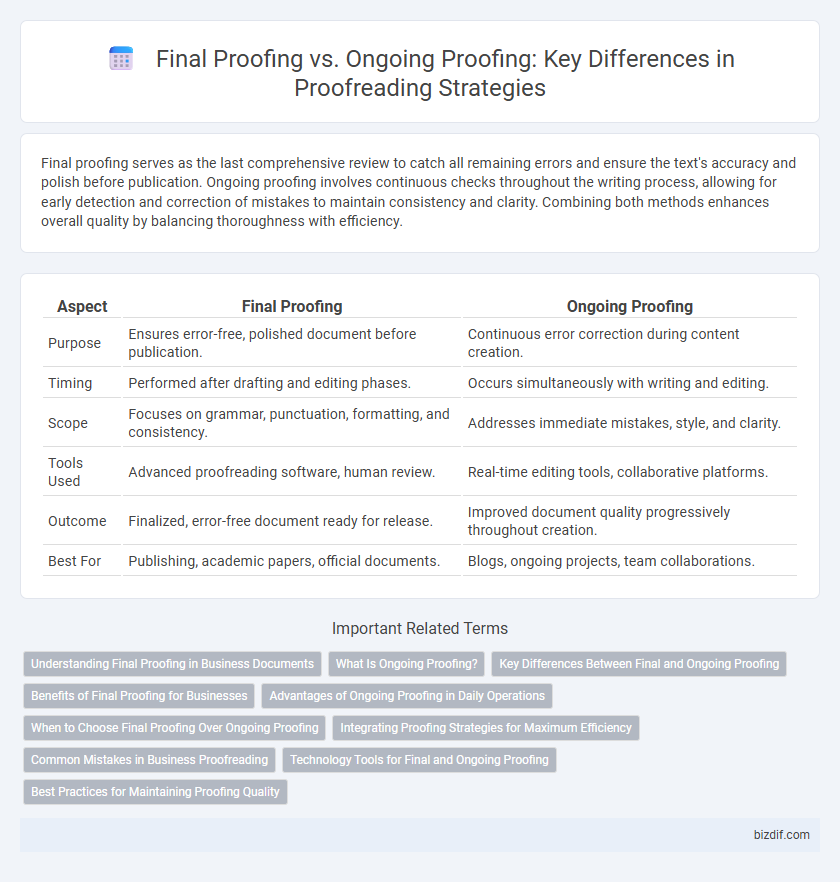Final proofing serves as the last comprehensive review to catch all remaining errors and ensure the text's accuracy and polish before publication. Ongoing proofing involves continuous checks throughout the writing process, allowing for early detection and correction of mistakes to maintain consistency and clarity. Combining both methods enhances overall quality by balancing thoroughness with efficiency.
Table of Comparison
| Aspect | Final Proofing | Ongoing Proofing |
|---|---|---|
| Purpose | Ensures error-free, polished document before publication. | Continuous error correction during content creation. |
| Timing | Performed after drafting and editing phases. | Occurs simultaneously with writing and editing. |
| Scope | Focuses on grammar, punctuation, formatting, and consistency. | Addresses immediate mistakes, style, and clarity. |
| Tools Used | Advanced proofreading software, human review. | Real-time editing tools, collaborative platforms. |
| Outcome | Finalized, error-free document ready for release. | Improved document quality progressively throughout creation. |
| Best For | Publishing, academic papers, official documents. | Blogs, ongoing projects, team collaborations. |
Understanding Final Proofing in Business Documents
Final proofing in business documents ensures complete accuracy and professionalism by meticulously reviewing grammar, spelling, and formatting before publication. This stage eliminates errors that could damage company credibility and mislead stakeholders, securing clear and concise communication. Unlike ongoing proofing, which involves regular updates during drafting, final proofing provides a definitive quality check essential for official releases and contracts.
What Is Ongoing Proofing?
Ongoing proofing is a continuous process of reviewing and correcting documents throughout the entire production cycle to ensure accuracy and consistency. Unlike final proofing, which occurs only at the end of the editing phase, ongoing proofing helps identify and resolve errors in real-time, improving overall quality control. This method minimizes the risk of overlooking mistakes, reducing the need for extensive rework during the final review stage.
Key Differences Between Final and Ongoing Proofing
Final proofing involves a comprehensive, last-step review to catch errors and ensure consistency before publication, while ongoing proofing occurs throughout the writing process to address issues as they emerge. Key differences include timing--final proofing happens after the entire document is complete, whereas ongoing proofing is continuous--and scope, with final proofing focusing on overall coherence and continuous proofing targeting incremental corrections. Both methods enhance accuracy, but final proofing prioritizes polish and completeness, whereas ongoing proofing emphasizes iterative improvement.
Benefits of Final Proofing for Businesses
Final proofing ensures that all content is meticulously reviewed for errors, enhancing brand credibility and customer trust in business communications. It minimizes costly mistakes before publication, reducing potential legal risks and the need for revisions. By delivering polished and accurate materials, final proofing supports consistent brand messaging and professional image management, ultimately driving higher customer engagement and sales.
Advantages of Ongoing Proofing in Daily Operations
Ongoing proofing enhances daily operations by enabling real-time error detection and continuous quality control, reducing the risk of costly revisions during final proofing. This proactive approach ensures consistent content accuracy and alignment with branding guidelines throughout the production cycle. Integrating ongoing proofing workflows accelerates project timelines and improves team collaboration, resulting in higher efficiency and output quality.
When to Choose Final Proofing Over Ongoing Proofing
Choose final proofing over ongoing proofing when your document is near completion and requires a thorough, comprehensive review to ensure error-free content before publication. Final proofing is ideal for catching residual typos, formatting inconsistencies, and factual inaccuracies that ongoing proofing might overlook. It provides a last quality control checkpoint, essential for formal documents, academic papers, or professional publications where precision and polish are critical.
Integrating Proofing Strategies for Maximum Efficiency
Integrating final proofing with ongoing proofing strategies enhances overall content accuracy by addressing errors at multiple stages of the editing process. Employing real-time proofreading tools during content creation reduces cumulative mistakes, while final proofing ensures polished, error-free output before publication. This combined approach streamlines workflow, improves quality control, and maximizes efficiency in content production.
Common Mistakes in Business Proofreading
Final proofing often misses errors like inconsistent tone and overlooked formatting issues that ongoing proofreading catches early. Common mistakes in business proofreading include typographical errors, incorrect data entries, and ambiguous phrasing that can mislead clients. Implementing both final and ongoing proofing strategies reduces costly errors and ensures professional communication accuracy.
Technology Tools for Final and Ongoing Proofing
Technology tools for final proofing prioritize accuracy and consistency, often utilizing advanced grammar checkers, plagiarism detectors, and style guides to ensure error-free content before publication. Ongoing proofing leverages real-time collaboration platforms and AI-powered writing assistants that provide continuous feedback and corrections during the drafting process. Integration of cloud-based editing software and version control systems enhances both final and ongoing proofing by facilitating seamless updates and tracking changes.
Best Practices for Maintaining Proofing Quality
Final proofing ensures the document is error-free before publication by focusing on grammar, formatting, and consistency in a comprehensive review process. Ongoing proofing integrates continuous quality checks throughout the writing and editing stages, enhancing accuracy and reducing cumulative errors. Implementing version control, standardized style guides, and collaborative review tools maintains proofing quality across all stages.
Final Proofing vs Ongoing Proofing Infographic

 bizdif.com
bizdif.com